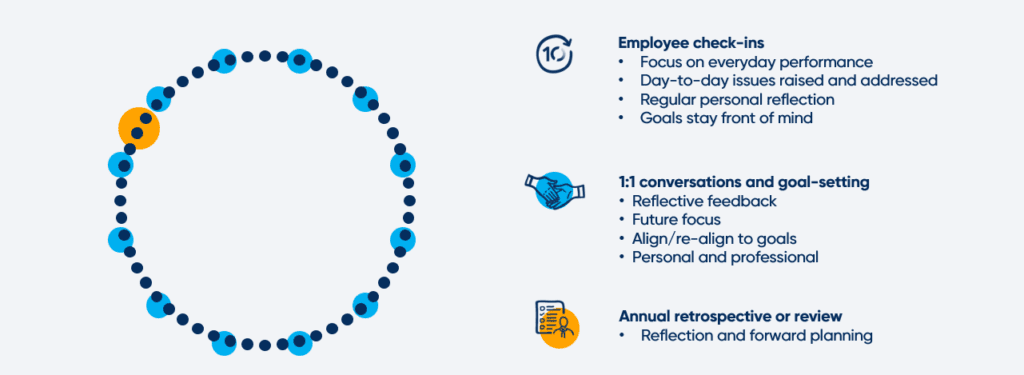Annual performance reviews don’t work. They’re an inflexible box-ticking exercise. Even before the global pandemic, this was a common view. Yet many organisations still use them. But it’s time for change. It’s time to explore the annual performance review alternative.
HR teams must move to everyday performance management. So employees are engaged and organisations agile. Flexibility and great communication are key success factors for businesses. And performance appraisals must reflect this.
But you can’t just flick a switch. You’ll need to convince your HR Director and the Board. And that’s before you tackle resistant managers. So, build your case, and compel them all to consider:
- What is everyday performance and the benefits as an alternative to annual reviews
- The steps to change from annual reviews to continuous performance
- Why manager mindset matters
An alternative to annual reviews – understanding everyday performance and its benefits
Traditional annual appraisals set objectives with a mid-year review (maybe). Then assess performance at year-end. And re-start the cycle. But one-off feedback processes don’t motivate employees. So, companies need an alternative to annual performance reviews.
For many, everyday performance is the best option. It’s built on flexibility, frequency, and feedback. And uses weekly, monthly and quarterly connections. So managers and employees can strengthen relationships and build trust.
Weekly check-ins
Two-way interactions between managers and employees focus on the day-to-day. And how to move things forward. Employees update managers on progress and highlight current challenges. Managers spot issues early. So they can provide appropriate support. The result is employees feel valued. And you can flex the format to suit individual needs.
Monthly 1:1 conversations
Review goals, both business and personal. Priorities change. And targets move. So monthly discussions offer reflection. And flexibility to change direction. They’re future-focused. And managers provide timely feedback. So employees can act and, if needed, make adjustments. Importantly, personal development becomes a monthly discussion point. So employees are motivated as managers actively seek out opportunities.
Quarterly goal-setting
A strategic view reviewing Objectives and Key Results (OKRs) and setting the next quarter’s goals. Annual performance appraisals are past-focused. They’re often also inaccurate, as details are forgotten. But quarterly goals build a clearer picture and allow re-direction where needed. Progress reports can easily be pulled from weekly check-in data. So employees reflect honestly on their performance. And managers can recognize a job well done. Or offer pro-active support to ensure success in the next quarter.
So that’s how it works. And why it’s more effective. But this is a shift. You can already hear the objections. So it’s time to create a plan. Making the change will take time. But the benefits of a flexible, forward-facing process are worth it.

Moving away from annual performance reviews: steps for introducing a new alternative
Moving to a future-focused everyday performance process takes effort. Not everyone embraces it. And not everyone’s good at it. So you need a plan to bring them with you. And get them delivering effective feedback to their teams.
Regular performance conversations
Make this change now. Don’t wait until you’ve introduced a new process. Frequent feedback drives productivity and engagement. Particularly when it’s timely recognition. So introduce future-focused discussions. Encourage regular check-ins. Get managers comfortable communicating with their teams. And offer support and training where it’s new or lacking as a skill.
Use continuous performance management as a sound alternative to an annual performance review
People think appraisals are admin-heavy. So find a system with flexibility. Give them a structure to record updates easily. Get multiple templates that are simple to use. Celebrate achievements with instant recognition. And make it employee owned. Performance reviews no longer need to meet an HR-defined timeline. Instead, they must be tailored to suit individual and business needs.
Get clear on goal-setting
Until now, annual goals were set and ignored. But effective goal-setting is essential to everyday performance. Clear business goals help employees see where they fit in the big picture. And personal goals offer career progression and increased engagement. So if managers aren’t sure, help them. Run small group and 1:1 sessions. Show them what great objectives look like. And how to use them effectively.
Why manager mindset matters when you switch to annual appraisal alternatives
Without leadership buy-in, everyday performance won’t work. Senior leaders must be clear on the vision and company values. So they can lead by example. And communicate messages clearly to others. Then managers can explain to employees where they fit in to the bigger picture.
And you need a culture of feedback. One that recognizes contributions. And flags potential concerns early. But not just at the lower levels. Everyone needs to know when they’re doing a great job. Or be given a chance to adjust their course. So executives must listen to employees. And address issues in the same way other managers are expected to.
Looking at alternatives to annual performance reviews isn’t straight-forward. It takes a phased approach and significant leadership buy-in. But to make that process smoother, start making changes now. And take a look at our Best Practice Guides to get your managers started on their journey to better communication today.



